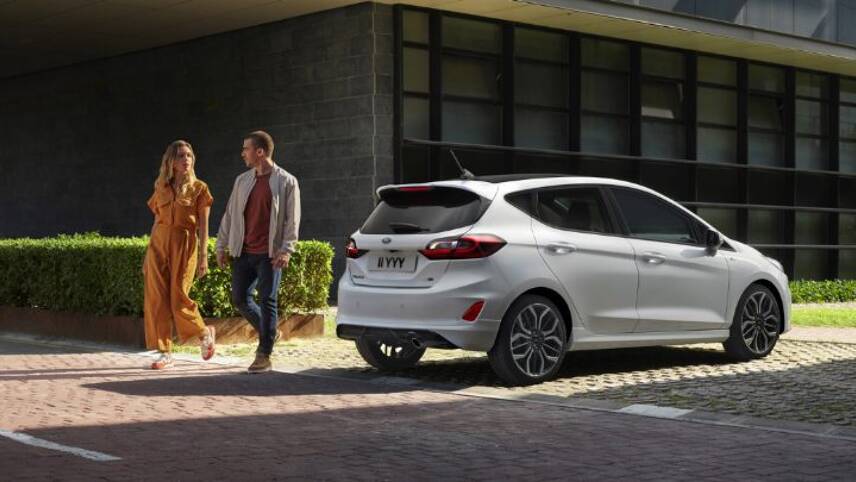Register for free and continue reading
Join our growing army of changemakers and get unlimited access to our premium content

Pictured: The updated Ford Fiesta model
The US-based company announced on Wednesday (2 March) that it has formed a distinct EV unit, called Ford Model e, and a distinct legacy business unit, Ford Blue. It said in a statement that it wanted to “win against both new EV competitors and established automakers” and that, while the units will “operate as distinct businesses”, they will “share relevant technology and best practices”.
Building on a commitment to invest at least $30bn in EVs by the end of 2025, Ford stated that the formation of Ford Model e will “accelerate innovation and delivery of breakthrough electric vehicles at scale”. Ford Model e will also be the part of the business tasked with developing vehicle software platforms and innovating the retailing experience.
Ford’s overarching EV goal is for one-third of all global sales to be accounted for by EVs by 2026, increasing to one-half of global sales by 2030. The firm will cease producing petrol and diesel cars in Europe by this point, given that the UK is banning new petrol and diesel car sales and the EU is mulling a similar move.
“Ford Model e will be Ford’s centre of innovation and growth, a team of the world’s best software, electrical and automotive talent turned loose to create truly incredible EV and digital experiences for new generations of Ford customers,” said the firm’s president and chief executive Jim Farley.
Operations for Ford Model e will be spread across locations in China, Kentucky and Tennessee. Ford’s former chief of advanced technology and officer for embedded systems, Doug Field, has been selected to head up Ford Model e.
As for Ford Blue, Ford has maintained that internal combustion engine (ICE) capacities are “still required” for “some situations”. It has not set a date for ending ICE vehicle sales globally, with SUV markets still booming in markets such as the US. Ford Blue will develop new models and derivatives relating to popular lines like the Ranger and Maverick trucks and the Bronco and Explorer SUVs.
In a statement, Ford said the decision to launch the new enterprises will not affect its 2050 carbon neutrality commitment or its pledge to only use 100% local renewable electricity in all manufacturing operations by 2035. Both businesses will work towards these goals.
Hyundai’s accelerated EV plan
In related news, Japanese carmaker Hyundai has announced plans to launch 17 new battery car models by the end of the decade, confirming £12bn of investment in EV R&D, manufacturing, marketing and infrastructure within this timeframe.
It will bring at least one new dedicated EV factory online within eight years as part of this commitment. This is in addition to the plant it is planning to open in Indonesia later this year.
The Korean company is forecasting that this move will enable it to claim 7% of the global EV market in 2030, by which point it aims to sell 1.87 million electric cars annually.
“Hyundai is successfully accelerating its transition to electrification and becoming a global leader in EVs despite a challenging business environment caused by the global chip shortage and ongoing pandemic,” said the firm’s chief executive Jaehoon Chang.
The commitment from Hyundai builds on a pledge, announced last September, to launch a hydrogen version of all models by 2028.
Nonetheless, Hyundai’s commitment to low-carbon mobility has been questioned in recent months. At COP26, the automaker was one of several not to sign up to a major new global commitment on ending the sale of vehicles that are not zero-emission. Shortly after the conference in Glasgow concluded, InfluenceMap named Hyundai as one of dozens of big carmakers allegedly lobbying for nations not to set Paris-Agreement-aligned policy packages.
45-Minute Masterclass: Electrifying your business fleet
Registration is now open for edie’s next free Masterclass, which is taking place on 29 March and will outline how businesses can integrate electric vehicles (EVs) into their fleets as they work to decarbonise.
This 45-minute online Masterclass is hosted in association with E.ON. It will take place at 1pm on Tuesday 29 March and will help businesses to formulate and deliver ambitious plans to reduce emissions from their fleets. Click here for a full agenda and to register.
Sarah George


Let us not forget that the electricity has to come from somewhere; and it has to be generated in that "somewhere".
There is no free lunch.
The largest proportion is generated by use of natural gas, which although it is a richer source of energy per tonne than coal, it is still a source of CO2.
In the UK we do not have a a great deal of hydropower. Wind power is unreliable and, in spite of personal windblown experiences, not a rich energy source:- yes, the greens will be incandescent, but there it is.
The richest source of power is nuclear, but we do not generate.at the moment, even our baseload, this could be nuclear, generation run at its most efficient.
But having joined nuclear energy research in 1954, I may be a little out of date, but I do not think so!!
Richard Phillips